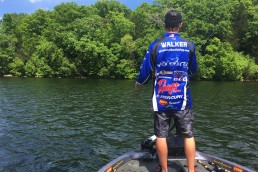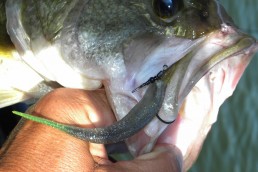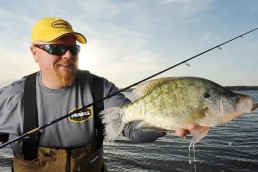Breaking Down the Drop-shot for Summertime Bass
SHARE THIS POST
A technique that has become a mainstay for bass fishermen who target bass offshore any season, but especially during the summer after this species has seen their fair share of baits, involves using the drop-shot method. This finesse presentation is a great way to target bass holding on isolated pieces of cover like rock piles or weed clumps. But these can also be used along a weedline, much the same way an angler would fish a Texas-rigged plastic.
One of the most important parts to remember about fishing a drop-shot is that the less movement you give the bait, the better you’re chances are for success. Whether you know it or not, your plastic bait is moving down under the water, even if you aren’t moving your rod. This may occur because of current in a river system or from wind blowing the water around, regardless if you keep a rod still or make slight movements, which is the best technique used for this finesse setup.
When fishing a drop-shot over rock piles, brush or weed clumps, you’re fishing directly over structure. You want to have your electronics set up in this situation so you can see your drop-shot sinker descend to the bottom and see the arches of the fish (hopefully bass) below. This way, when you see an arch on the screen you can move your drop-shot slightly and get that bass in the boat.
When fishing offshore areas, the Spot-Lock feature on my Minn Kota keeps me locked onto a spot and allows me to focus on fishing and not running the trolling motor. This makes a huge difference when wind and current make boat control a nuisance.
If you’re making casts with your drop-shot to a weedline, just cast it to that cover, let it sink to the bottom, let it sit there, and then slowly drag it back to the boat. The amount of weight you need to get down there should be as light as possible, depending on the wind and if you need to get it through any thick vegetation.
Are you enjoying this post?
You can be among the first to get the latest info on where to go, what to use and how to use it!
The equipment for drop-shotting is important for success because it helps you so you can feel the bites better to get the bass into your boat. This all starts with the rod.
A good drop-shot rod should have a soft tip so you can give your baits the proper subtle action. But it should also have strong backbone to get a big bass into the boat. Once I feel the bite, I reel up the slack and give my rod a sideways sweeping hook-set. Sometimes when a bass bites your drop-shot it’s a subtler, softer bite. One of the ways to feel that lighter bite is by using a high-quality fluorocarbon line. A strong, sensitive fluorocarbon will help you feel more bites and keep your line free of nicks. What pound of test you use depends on the water clarity, but in most circumstances I use 6- to 10-pound-test line.
The Seaguar Finesse Fluorocarbon gets spooled up on my reels and it’s a double-structured fluorocarbon (like TATSU), which combines two custom resins to create a line that’s available in smaller diameters. It still delivers superb knot and tensile strength. Since the introduction of fluorocarbon, anglers have had issues with it coming off their spinning reels (a standard for finesse-fishing applications) with a lot of memory. This is a thing of the past with the Finesse Fluorocarbon, as it is very soft and supple, giving it very low memory.
The drop-shot is a versatile application for finicky bass as the plastic you rig on the hook can be rigged in three different ways:
- Nose hook, a great choice when fishing open water as it gives the bait more action. Rigging is easy. Just poke the barb through the bottom of the bait, bear the nose and push it all through. Use a hook that has a built-in swivel to eliminate line twist.
- Texas rig, an ideal choice when fishing around cover as the hook point is covered up. My hook choice here is the TroKar TK180 Light Wire Finesse Worm hook in a 1/0 to 3/0 size depending on the size of plastic, which could entail a Zoom Finesse Worm or Fluke Stick Jr.
- Wacky rig, which is a similar way to fish the bait to the nose-hooked option, but gives the bait a different look and can trigger a bite when it gets tough.
Another rigging item to pay attention to with a drop-shot is the length of the dropper line. This is the line from the eye of the hook down to your weight. How long this is will depend on how heavy the cover is and how far off the bottom the bass are suspended. I usually have a dropper line anywhere from 12 to 18 inches in length and use a drop-shot weight that is 3/16 ounce.
MWO
SHARE THIS POST
Did you enjoy this post?
You can be among the first to get the latest info on where to go, what to use and how to use it!
Glenn Walker
Glenn Walker has been fishing Minnesota and Mississippi River tournaments for more than 15 years, spreading his passion and knowledge of the sport via articles and videos. For more information, check out glennwalkerfishing.com or on Facebook @GlennWalkerFishing.



